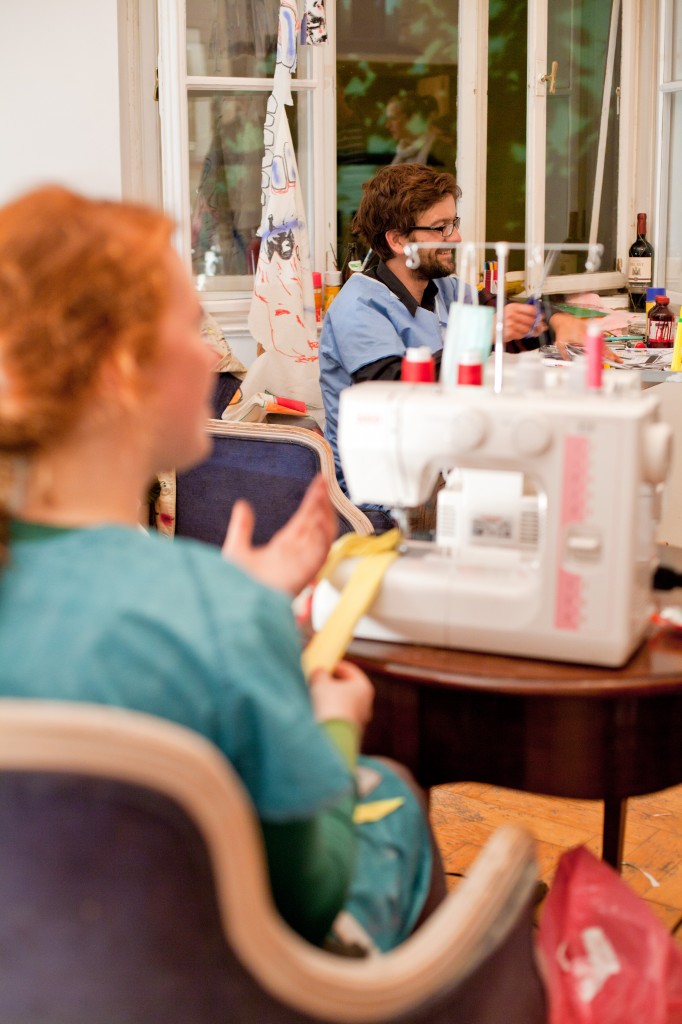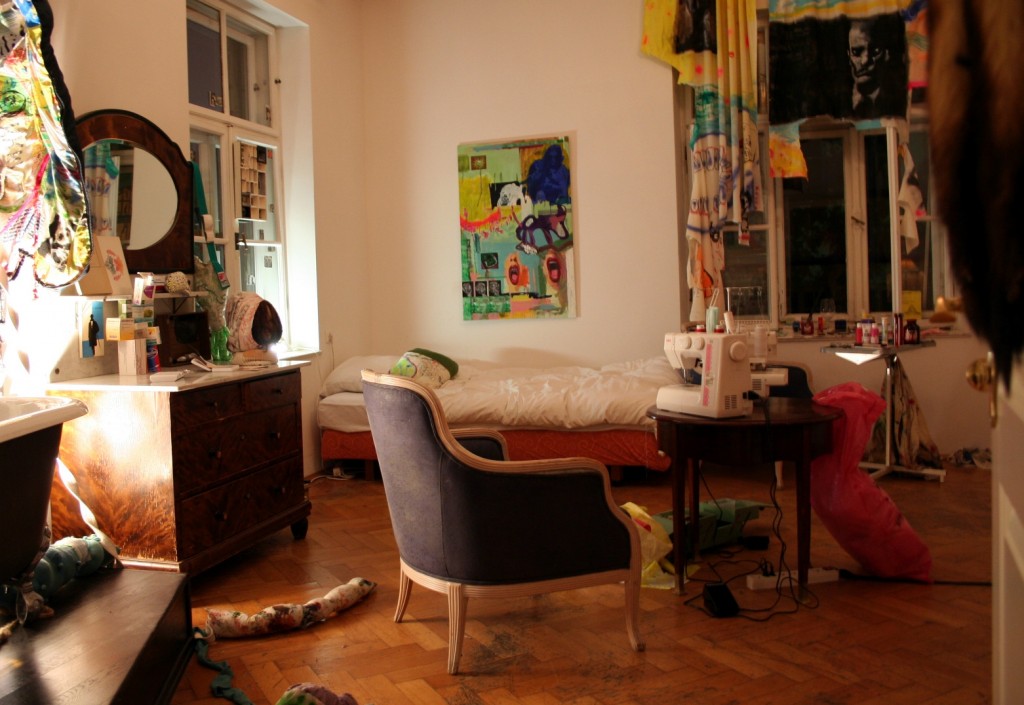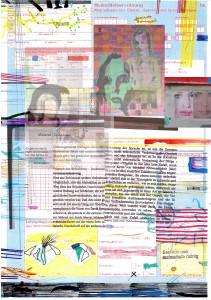 Last October thirteen international young artists were showing their work in an old hotel in Munich, called Mariandl. Two of them – Stephanie Müller and Klaus Erich Dietl – transformed one of the hotel rooms into a therapy room. The room itself as well as their therapeutic concept was a combination of surrealism and humorous naiveté.
Last October thirteen international young artists were showing their work in an old hotel in Munich, called Mariandl. Two of them – Stephanie Müller and Klaus Erich Dietl – transformed one of the hotel rooms into a therapy room. The room itself as well as their therapeutic concept was a combination of surrealism and humorous naiveté.
The performance started by entering the room and reading a note, taped to the door, with a quote by Henry Miller that reflected on the modern fascination with psychoanalysis:
But if you realize that he [psychoanalyst] is not a god but a human being like yourself, with worries, defects, ambitions, frailties, that he is not the repository of an all-encompassing wisdom but a wanderer, like yourself, along the path, perhaps you will cease pouring it out like a sewer, however melodious it may sound to your ears, and rise up on your own two legs and sing with your own God-given voice. To confess, to whine, to complain, to commiserate, always demands a toll. To sing it doesn’t cost you a penny. Not only does it cost nothing – you actually enrich others. […][1]
The narrator, here, questions the psychoanalyst`s godlike role and demands to look for a godly element in yourself. He gives the advice to change one´s attitude towards (what is considered to be) ‘baggage’. Instead of treating it like waste that one has to get rid of, one should handle it in a more creative way that could help regaining a confidence in oneself.
The hotel room in Munich itself was flooded with surrealistic references. Everything seemed to come out of a dream. In a closet there were figures from German fairytales – red riding hood and the big bad wolf – that were disfigured but still possessed a certain cuteness. Red riding hood was a little larva hanging from a hanger, the big bad (and bloody) wolf was depicted as, and reduced to, a motive on a t-shirt hanging in the same closet. A pillow in the shape of an eye was staring at you from another closet and when you peeked inside it was doubled by an inner mirror; pillows with Freud´s face on it were cluttered all over the room.
However, the most prominent surrealistic reference was a sewing machine positioned in the centre of the room. In surrealism the sewing machine became an important symbol through the well-known quote by Lautréamont “[…]beau comme la rencontre fortuite sur une table de dissection d’une machine à coudre et d’un parapluie!”[2] Lautréamont’s arrangement is an illogical one; it cannot be found in reality because nothing connects these elements to one another. They can only be linked by the imagination, by a radically subjective perspective, which the surrealists tried to access by focusing on the subconscious.
 However, in the exhibition in Munich the sewing machine was more than a reference, it was not simply a part of a random composition. Stephanie Müller actually used it – she sewed on it. This switch from reference into useful instrument distances the performance from the surrealistic mindset and at the same time binds it closer to it, because it enables a connection to everyday life (something the surrealists were working on, too). The sewing machine was for this reason a fitting choice, since it is associated with a form of everyday creativity.
However, in the exhibition in Munich the sewing machine was more than a reference, it was not simply a part of a random composition. Stephanie Müller actually used it – she sewed on it. This switch from reference into useful instrument distances the performance from the surrealistic mindset and at the same time binds it closer to it, because it enables a connection to everyday life (something the surrealists were working on, too). The sewing machine was for this reason a fitting choice, since it is associated with a form of everyday creativity.
Surrounded by little piles of textiles, Stephanie Müller took on the role of the therapist. She created self-made products that were meant to help the visitors with their issues (if they had any and if they were willing to share them). Whatever the problems were, she tried to find an original response to it. One girl had issues with time management, so Stephanie Müller created an oversized clock which might as well serve as a small pillow to relax on. Another visitor was telling them about being new in town and not knowing how to respond to different people and how to deal with the friendships she has made. A textile map was designed for her together with some small figures, which she could stick on the map and with which she could playfully try out different social constellations or, if fed up with it all, take herself out of the equation by removing the figure that represented her. Again, the textile materiality helped the creation of yet another use: the map could also serve as a blanket, as a little piece of home in a new town.
 Klaus Erich Dietl – Stephanie Müller`s partner – added another element to the performance by creating prescriptions for their ‘patients’. He was the one who formalized the whole therapeutic procedure by giving out some kind of false legal documents. He sampled different types of materials, painted over them, yet kept a form that similar to typical (german) prescriptions. He was the rational force that created irrational documents, and by doing this he grounded the surrealistic experience in the real world without bringing it back to reality completely.
Klaus Erich Dietl – Stephanie Müller`s partner – added another element to the performance by creating prescriptions for their ‘patients’. He was the one who formalized the whole therapeutic procedure by giving out some kind of false legal documents. He sampled different types of materials, painted over them, yet kept a form that similar to typical (german) prescriptions. He was the rational force that created irrational documents, and by doing this he grounded the surrealistic experience in the real world without bringing it back to reality completely.
The therapeutic advice has to be related to the attitudes both artists displayed. They responded to the world in a naïve way and they offered a practical (textile) solution to everyday problems. These approaches are reminiscent of childhood – taking a relaxing nap when you can´t go on, snuggling with your favorite blanket that reminds you of home when you are homesick, and so on.
The approach itself was not as analytical as one would expect when dealing with psychoanalysis. Instead it was very agency-based and linked to actual materiality. Although the performance by Müller and Dietl displayed a fascination for the subconscious, the real issues were taken as they were – there was no search for a deeper, hidden reason behind the issues. What was on the surface was treated right away. Also, you got a prescription, an assurance that you were helped. It´s similar to a kid´s band-aid which indicates that something is being treated, in a simple, easy and untroubled way. This is what both artists tried to supply for that one moment inside that one hotel room – a light-hearted, momentary relief.
[1] Miller, Henry: Sexus: The Rosy Crucifixion, Book I, New York: Grove Press, 1965, pgs. 339-341.
[2] Ducasse, Isidore [‘Le Comte de Lautréamont]: Les Chants de Maldoror, Paris: Imprimerie de Balitout, Quesnoy et Cie., 1868-70, Book VI, strophe III,p. 215-17 (trans. Paul Knight, Maldoror, Harmondsworth, Middlesex, England: Penguin Books, 1978: “[…] beautiful as the chance meeting on a dissecting table of a sewing machine and an umbrella!”)
Photographies by Joachim Betz (first image) and Stephanie Müller (second and third image)

Nadine—It sounds like the perfect experience for this land-locked KS gal. Thank so much for sharing!
ps)I am just beginning to study Narrative. Like Metamodernism, I’ve always had Narrative within me. I would love to read more of your thoughts connecting the two subjects.